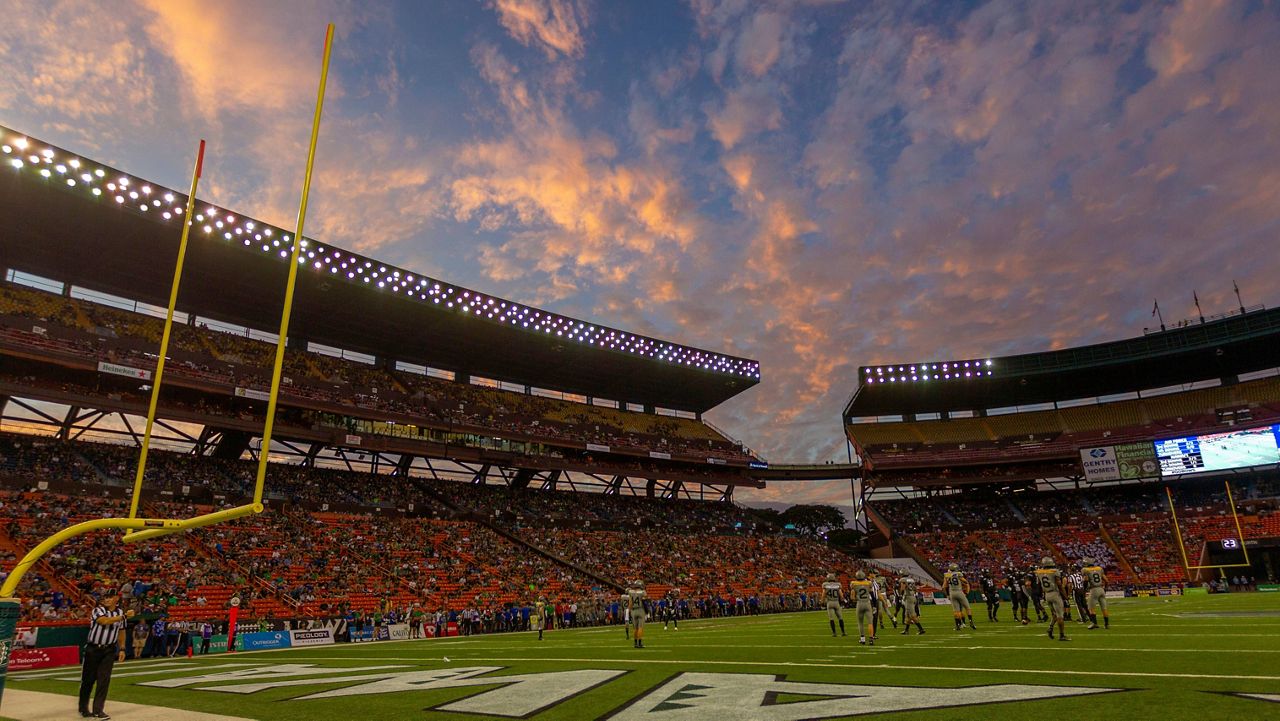HONOLULU — The goalposts have moved once again for Oahu’s stadium project.
The latest estimates of capacity for a new $350 million venue in Halawa are 25,000 seats, or perhaps only a few thousand more, Spectrum News confirmed on Saturday. That’s about 10,000 fewer seats than were originally envisioned when the New Aloha Stadium Entertainment District initiative was introduced in early 2021 — and half of the 50,000 capacity of decommissioned Aloha Stadium.
Newly sworn-in Gov. Josh Green has honored a campaign commitment to jump-start the stalled stadium Request for Proposals process for public-private partnership (P3) bidding that stalled under his predecessor, David Ige, people familiar with the situation told Spectrum News.
Green held a meeting with cabinet members and Stadium Authority members this week to discuss strategy.
The good news, State Sen. Glenn Wakai said, is that Green is serious about moving quickly to make up for lost time.
“From what I was told, (Green) made it clear he wanted the RFP signed before the State of the State Address in the latter part of January,” said Wakai, whose purview includes the 98-acre Halawa site where NASED is to combine a stadium, housing and entertainment.
Green, who supports mixed-use development on the grounds with an emphasis on affordable housing, told Hawaii News Now that he believes a 25,000-seat stadium can open in 2027, in line with the time projections prior to Ige’s decision to halt the RFP process in September.
But while, for once, the projected finish line for the project was not moved back, it appears to have proved costly in another way.
“At one point we were talking 35,000 (seats), right, but that was a year and a half ago,” said Wakai, who faults Ige for about $25 million in ever-rising construction costs, contributing to the smaller and smaller specifications.
Instead of P3 bidding, Ige and his director of Department of Business, Economic Development and Tourism, Mike McCartney, favored a straight design-build of a stadium by a state entity with the newly supplied $350 million from the Legislature before the rest of the development would be addressed.
“(Now) I think 25,000 is realistic for what we want to get accomplished,” Wakai said.
Any fewer than that would be unacceptable, he added. Versions that have been looked at recently have included the ability to expand it at a later time to about 30,000. The original three teams of would-be P3 bidders still remain in the fold, Wakai said, after standing by for months.
Meanwhile, the University of Hawaii, which would be the primary tenant in the new stadium, is going ahead with its $30 million plans to further retrofit the on-campus Clarence T.C. Ching Athletics Complex into a medium-term Division I football venue.
Once the Dec. 24 EasyPost Hawaii Bowl between San Diego State and Middle Tennessee State at the Ching Complex is out of the way, UH will begin work to remove its track from the venue and expand seating to about 17,000 from about 9,300. In theory, most of the expansion will be ready in time for the 2023 season.
Given that, the latest seating figure for the planned stadium in Halawa made attorney Jeff Portnoy, a former member of the UH Board of Regents, balk.
“I’m not so sure, if the university expands its facility to 17,000 on campus, why they need a stadium out in (Halawa) with only 8,000 more seats,” Portnoy told Spectrum News. “I mean, I don’t get that. It seems to me, if I’m the university and I can expand my facility to 17,000 … why would I want to go to a facility that has another 8,000 seats but is 20 miles from campus, and all the problems that that raises? But that’s up to the university.”
He acknowledged, however, that not all venues of similar sizes are created equal. The Ching Complex’s bleacher seats have already become notorious for their close confines, and UH must still bring in portable bathrooms every game.
Portnoy still thinks 35,000 is the ideal — if not for the struggling Rainbow Warriors of today, then for future generations who might enjoy more success.
The specifications and wish list items for a new Halawa stadium — the 47-year-old one must still be torn down — have changed quite a bit from the hopeful early days of NASED.
A person familiar with the inner workings of the Stadium Authority told Spectrum News that the body is still focused on getting a venue that will attract other sporting events like soccer and rugby, and concerts to the stadium. Features like lighting and staging equipment for concerts, and cantilever roofing, or the ability to add it later, would go far in that regard, the person said.
Two of UH’s Mountain West Conference football brethren, Colorado State and San Diego State, have recent experience successfully constructing stadiums. CSU’s Canvas Stadium, capacity 41,000, opened in 2017. SDSU’s Snapdragon Stadium, base capacity of 35,000, opened this year.
They were hailed as success stories.
“I don’t get it. There’s something wrong here,” said Portnoy, who thought a new stadium should’ve been pursued to replace the deteriorating Aloha Stadium a decade ago. “The whole problem is that the powers that be were asleep ... including the Legislature in particular, and now they have led to this situation, which we’re still talking five years from now, if you’re lucky.”
Brian McInnis covers the state’s sports scene for Spectrum News Hawaii. He can be reached at brian.mcinnis@charter.com.



